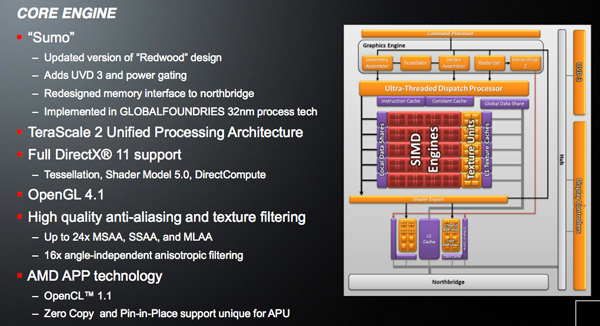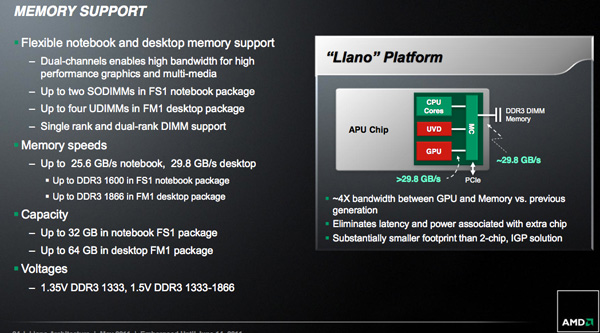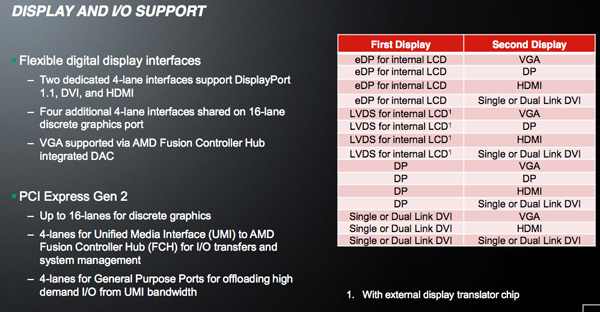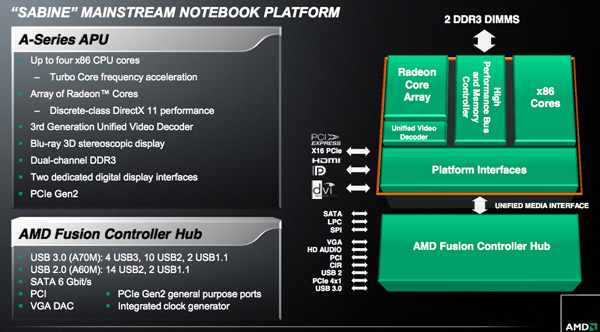The AMD Llano Notebook Review: Competing in the Mobile Market
by Jarred Walton & Anand Lal Shimpi on June 14, 2011 12:01 AM ESTThe GPU
While the Llano CPU cores may be in need of a major overhaul, Llano's GPU is as new as it gets. Technically based off of AMD's Redwood core (Radeon HD 5570) with some enhancements, Llano's GPU is codenamed Sumo.
The DX11 GPU features five SIMD arrays, each with 80 cores for a total of 400 shader processors. Similar to the updates we saw with this year's Northern Islands GPUs, Sumo does add UVD3 support to the Redwood architecture. Of course since Sumo shares the same die as the Llano CPU cores it is built on GlobalFoundries' 32nm process, making this the first AMD GPU fabbed at GlobalFoundries and not TSMC.
For everything behind the memory controller Sumo is virtually identical to Redwood. Where Sumo differs is in its memory interface. Although Llano is AMD's first performance oriented APU, it's still constrained by a 128-bit wide DDR3 memory interface. That dual-channel memory interface has to be shared by all four Llano cores as well as the Sumo GPU and as a result, arbitration is very important.
AMD shared a few choice details about the Llano memory controller architecture. To begin, AMD guarantees more than 30GB/s of bandwidth is available between the GPU and the memory controller—in other words, the path from GPU to the memory controller won't become a bottleneck. The GPU/memory controller link (i.e. within the APU die) can apparently scale up to as much as 50GB/s to support future APUs with even faster memory interfaces. Note that unlike previous integrated graphics solutions, there is no support for dedicated external memory—this is a pure shared memory architecture.
Second, and most importantly, AMD can dynamically prioritize memory bandwidth between the CPU and GPU. In most cases, when both processors are heavily consuming data, the GPU is given priority over the CPU. Given today's workloads, prioritizing the GPU for memory accesses makes sense when it's running full tilt. The chances of you stressing all four CPU cores and running at full GPU memory bandwidth requirements are pretty slim today.
With 400 shader processors behind a shared 128-bit DDR3 memory interface, the upper bound for Sumo performance is the Radeon HD 5570. In practice, you should expect performance to be noticeably lower since the GPU does have to share its precious memory bandwidth with up to four x86 CPU cores.
The mobile version of Llano supports up to DDR3-1600 while the desktop parts can run at up to DDR3-1866. Maximum memory capacities are 32GB and 64GB for notebooks and desktops, respectively.
Llano has a total of 24 PCIe Gen 2 lanes at its disposal. Sixteen of those lanes can be used for external graphics. Four of the lanes can be used for devices that need low latency/high bandwidth access to the APU itself (e.g. Gigabit ethernet). The remaining four lanes are used to connect the APU to its sole partner in crime: the Fusion Controller Hub.
AMD is particularly proud of the display output configurations supported by Llano. The possible combinations are listed below:
Chipsets
AMD will offer two Fusion Controller Hubs (FCHs) as options for Llano: A70M and A60M. The only difference between the two is in their support for USB 3.0; the A70M has four USB 3.0 ports while the A60M has none.
Both FCHs support 6Gbps SATA and perform just as well as AMD's 8-series chipset (or Intel's Z68) with a high performance SSD. USB 3.0 performance is also comparable to 3rd party solutions we've seen deployed on motherboards already.















177 Comments
View All Comments
sinigami - Tuesday, June 14, 2011 - link
these prices, are definitively NOT in the netbook range:$500 - thinkpad x120e
$550 - HP Pavilion dm1
$600 - sony vaio YB
who the hell would pay that much dough for Atom level performance?
sinigami - Tuesday, June 14, 2011 - link
even AMD's slower 1.0GHz C-50, costs more than the Atom in the SAME MODEL netbook (while benchmarking slower than the atom!):$250 - Acer Aspire One 255 with the FASTER Intel Atom
$330 - Acer Aspire One 522 with the SLOWER AMD C-50
ET - Wednesday, June 15, 2011 - link
First of all, the (lowest) prices I found at Amazon.com were $250 for the 255 and $310 for the 522, which is a smaller margin.Acer 522 has a 720p display vs. the 255's 1024x600. That alone is worth a significant price difference. It also has a HDMI port and a CPU (APU) that can play 1080p HD videos (or 720p on the internal display). The 255 is worth crap for video playback, a very common laptop use these days.
The C-50 can also play some games. Sure, older ones and at low settings, but it's something the 255 simply can't do.
In terms of general performance, the C-50 should be competitive with the Atom when it comes to web browsing and word processing.
In short, the 522 is so much better than the 255 that a $60 premium is really not a lot.
sinigami - Wednesday, June 15, 2011 - link
"But, but, the 522 has an HDMI port on it!".Personally, i wouldn't pay $80 more for a netbook that is even SLOWER than an atom, no matter how much lipstick they put on that pig -- i mean, no matter how many hdmi ports they stick on that snail.
And they could stick whatever size screen they want on it, and i'm sure they would charge a whole lot more if they put a 55" on it, but i'd surely NOT buy it with a C-50 in it....
more bluntly: Acer could put a 1080p display on it, add USB 3.0, give it an amazing sound system, etc, and then charge $1000, but who wants a Ferrari with a Yugo engine?
ET - Thursday, June 16, 2011 - link
Forget the C-50 vs. Atom. Would you pay more for an Atom netbook if it had a higher resolution screen? If not, then fine, but I'm sure many people would. 1024x600 is too low for comfort.From your post it looks like you're just trolling, since you stick to "$80 more" even though it's $60 in reality, ignore any comfort from higher resolution and continue to insist that the C-50 is "SLOWER" in caps even though it would beat the Atom in the 255 on SunSpider and probably other benchmarks of real world usability. So I think the prudent thing to do would be to refrain from replying to you, and I will try to do that in the future.
sinigami - Thursday, June 16, 2011 - link
Sorry mate, i'm just slow, not a troll... though it's easy to confuse dain bramage with trolling.When i looked at amazon i saw their black one was "Currently unavailable", and the colored ones were $330. I didn't spot the black BZ465 that IS available for $310, so i cede to you that it is only a $60 difference.
My apologies.
"Forget the C-50 vs. Atom. Would you pay more for an Atom netbook if it had a higher resolution screen? If not, then fine, but I'm sure many people would."
That is a reasonable point. $60 is worth it to many people for a better netbooking experience. There is a LOT of value in a highly portable 10" netbook, with hours and hours of battery life, that you can toss anywhere (even a purse), and it does it's intended job of surfing and playing video (not 1080p, of course, but why would it, it has a freaking tiny screen), with a real keyboard and trackpad (and USB ports - take that, ipad). And with a dirt-cheap price, it's all smiles for "many people".
BTW, i did pay more, lol, except i had to go for an 11.6" screen (@1366x768), even though it isn't as tossable.... i also sprang more for an ultra-low-voltage, dual-core, U/SU chip, so i can have a little more fun, wasting hours on boxcar2d!
ET - Wednesday, June 15, 2011 - link
Where did you get these prices? The HP is $450 (3GB RAM, 320GB disk). The Lenovo is normally $440 for the E-350 version (though currently backordered). It's not rare to be able to get them for less.This is still more than netbooks, but it's for a better spec and better performance.
sinigami - Thursday, June 16, 2011 - link
(sorry, i admit my prices were not current, the price has gone down and i haven't kept track)still, that is getting very close to the price range where you can get a much better spec, and way, WAY better performance.
the performance that becomes available, for a few dollars more, first jumps to twice that of an Atom or Zacate, and then you get to the budget i3's, which are, at the least, FOUR times as powerful as an atom or E-350.
sinigami - Tuesday, June 14, 2011 - link
i fully appreciate netbooks for what they are, and i know better than to do anything more demanding than play my 720p MKV anime on a netbook (yes, even the latest Atom machines can do this).I'm just pointing out that, currently, with the Brazos and Zacate Fusion APUs, AMD is NOT hitting the price/performance spot that i expected them to.
the Zacate 1.6GHz E-350, should be priced the same as the Atom machines, up to the price of the Atom/Ion machines.
i was hoping for AMD's tradition of price/performance to continue, and that would have meant beating or at least NOT being more expensive than Intel!
and the C-50 is even worse!
iwod - Tuesday, June 14, 2011 - link
I was wondering if they used the latest drivers from Intel, which offer some performance increase. And on the notes of Drivers, GPU drivers these days matter a lot more then Hardware. And ATI has had YEARS of Hard Work on their drivers. While Intel is working hard now, although in terms of catch up they are rather slow.Which brings the questions, If Intel really did improve their drivers and bring extra 10 - 20% increase. The Liano doesn't look that attractive at all.